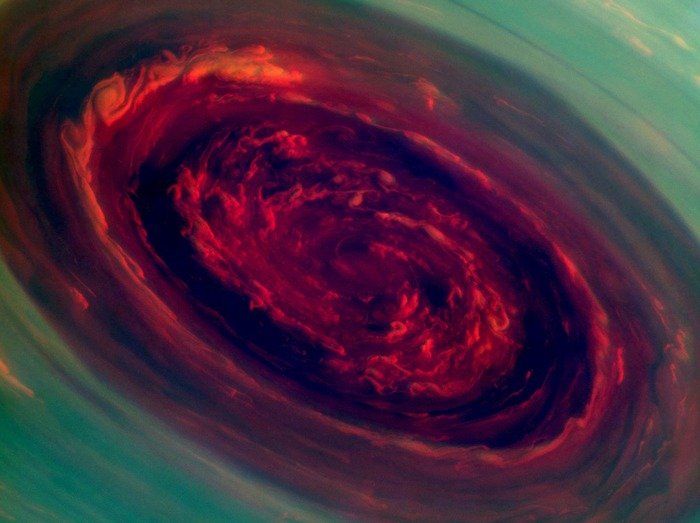The spinning vortex of Saturn's north polar storm seen in this false-color image from NASA's Cassini spacecraft. Image credit: NASA/JPL-Caltech/SSI
PASADENA, Calif., April 29 (UPI) -- NASA says the Cassini spacecraft has sent back the first close-up, visible-light views of a behemoth hurricane swirling around Saturn's north pole.
High-resolution pictures and video indicated the hurricane's eye is about 1,250 miles wide, 20 times larger than the average hurricane eye on Earth, the space agency reported Monday.
Thin, bright clouds at the outer edge of the hurricane are traveling at 330 mph, scientists said.
"We did a double take when we saw this vortex because it looks so much like a hurricane on Earth," said Andrew Ingersoll, a Cassini imaging team member at the California Institute of Technology in Pasadena. "But there it is at Saturn, on a much larger scale, and it is somehow getting by on the small amounts of water vapor in Saturn's hydrogen atmosphere."
Although there is no body of water such as an ocean close to these clouds high in Saturn's atmosphere, learning how these storms use water vapor could help reveal more about how terrestrial hurricanes are generated and sustained, the scientists said.
Unlike terrestrial hurricanes, which tend to move, the hurricane on Saturn is locked onto the planet's north pole. On Earth, hurricanes tend to drift northward because of the forces acting on the fast swirls of wind as the planet rotates.
The one on Saturn, which is believed to have been churning for years, is already as far north as it can be, scientists say.
"The polar hurricane has nowhere else to go, and that's likely why it's stuck at the pole," said Kunio Sayanagi, a Cassini imaging team associate at Hampton University in Hampton, Va.
The Cassini-Huygens mission is a cooperative project of NASA, the European Space Agency and the Italian Space Agency.















